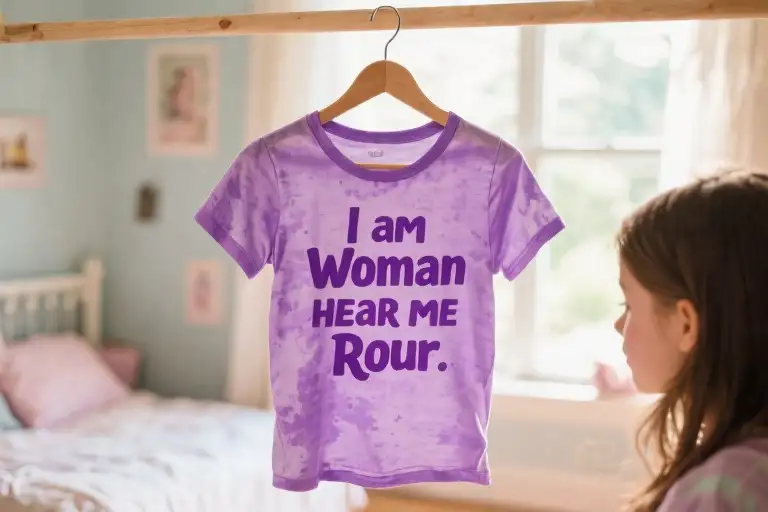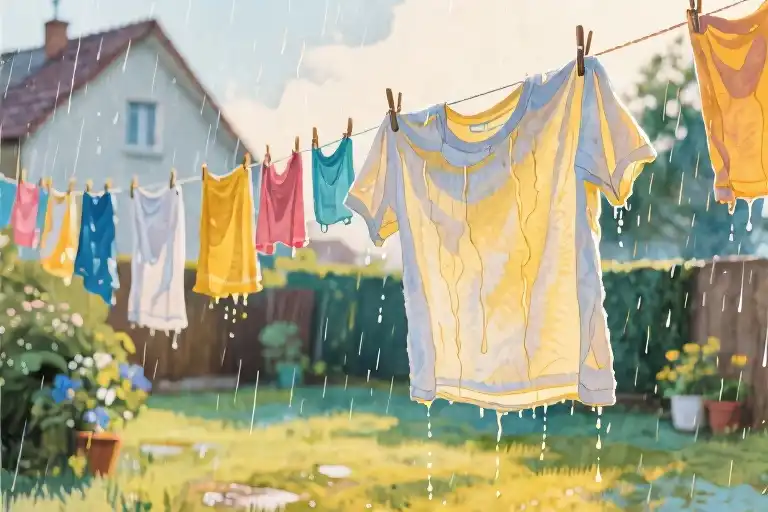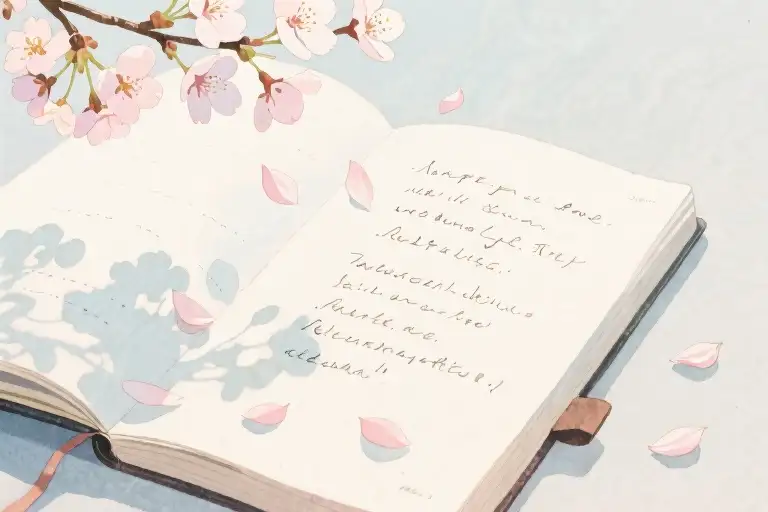The fluorescent lights of Foot Locker make the white cotton glow like fresh snow. At eleven, I press my fingers against the rack, the metal cool under my fingertips. Then I see it—the shirt that stops my breath. Crisp fabric with bold purple letters shouting across the chest: I am woman, hear me roar.
The declaration thrums through me, electric. That phrase isn’t just printed on fabric; it’s the anthem my bones have been humming since I learned to walk. Without trying it on, I know. This shirt isn’t something I’ll wear—it’s armor I’ll inhabit.
‘Mom!’ My voice bounces off the mall’s tiled walls. ‘This one. This is the one.’ The purple ink smells faintly chemical when I hug the shirt to my chest, like possibility still wet from the printer. That scent mingles with popcorn from the food court and the waxy perfume of new sneakers—a sacred cocktail of adolescence.
Four years later, that same shirt hangs limp in my closet, its collar stretched from too many washes. The purple letters have faded to bruised lavender, the fabric gone from radiant white to the color of old newspaper. My stomach knots when my fingers brush the hem. What was I thinking? The memory of middle school hallways echoes—snickers bouncing off lockers, boys’ eyes rolling at my chest’s bold claim. That shirt didn’t make me roar; it made me a target.
Between eleven and fifteen, something vital slipped away. Not just confidence, but the unshakable certainty that my voice deserved space. The shirt’s transformation mirrors my own: vibrant colors muted, bold edges softened into palatable nothingness. Research shows 66% of girls start suppressing their voices in PE class alone by age twelve—swallowing cheers to avoid seeming ‘too much.’ My shirt became a relic of that silencing, its message now reading like a question: Did I ever really roar at all?
Yet here’s the quiet rebellion: I never threw it away. That faded cotton holds more truth than any pristine garment ever could. It’s proof that voices can be rediscovered—not in the brash purple of childhood, but in the subtle strength of stains survived.
The Shirt That Roared
The fluorescent lights of Foot Locker made the white cotton glow like a beacon. At eleven years old, standing on tiptoe between racks of basketball jerseys, I knew I’d found my armor—a crisp crewneck tee with bold purple letters declaring: I am woman, hear me roar.
My fingers tingled touching the raised print. The shirt smelled like department store starch and possibility. ‘Mom!’ I called across the aisle, clutching the hanger like a winning lottery ticket. She turned from the sneaker display with that familiar half-smile—the one that said I don’t understand your obsession with graphic teens but I’ll humor you.
‘That’s… quite a statement,’ she said, smoothing the fabric between her thumb and forefinger. I watched her eyes scan the Helen Reddy lyric now permanently linked in my mind to empowerment. At that moment, the shirt wasn’t just clothing—it was my first manifesto. The purple ink might as well have been neon paint splashed across a protest sign.
In the fitting room mirror, I struck power poses while the tag scratched my neck. The oversized shoulders made me feel like a tiny CEO. ‘This is what I mean!’ I whispered to my reflection, imagining classmates seeing me stride down the hallway broadcasting this truth. That summer, I’d worn out my Free to Be… You and Me cassette until the tape ribbon frayed. Now I had my own anthem stitched in cotton.
Looking back, my understanding of ‘roaring’ was deliciously naive—a child’s interpretation of feminism as pure volume. At eleven, roaring meant singing off-key at recess, arguing with the boys about who ran faster, wearing my favorite purple jelly shoes until they disintegrated. The shirt became my uniform for those small acts of rebellion.
But beneath the surface, something more profound was taking root. That $12.99 garment represented my first conscious act of self-definition. Research from the Girls’ Leadership Institute shows ages 10-12 are peak years for girls’ self-assurance—a fleeting window before societal pressures begin silencing their voices. My Foot Locker find accidentally coincided with this developmental sweet spot, giving tangible form to my unfiltered selfhood.
The memory still makes me smile: how seriously I deliberated between the purple or pink lettering (purple felt ‘more powerful’), how I insisted on wearing it the first day of sixth grade despite my mom’s gentle warning that ‘some people might not get the reference.’ What strikes me now isn’t the shirt itself, but the unselfconscious certainty with which that girl claimed her space in the world. Before she learned to fold herself into smaller, quieter shapes.
That autumn, I’d spin in front of my bedroom mirror watching the declaration ripple across my chest, practicing how to ‘roar’ in different tones—playful, defiant, matter-of-fact. If only I’d known then how precious that instinct was, how hard it would be to recover once lost. How soon the world would begin teaching me that some silences are expected of women, even those wearing their convictions in boldface type.
The Fading Purple
At twelve, something shifted. The white t-shirt that once felt like a battle cry now hung limp in my closet, its purple letters fading like my courage. I’d wear it under hoodies now, button-ups hastily thrown overtop—as if hiding the shirt could hide the parts of myself that no longer felt acceptable.
The Unspoken Rules
Middle school hallways taught brutal lessons no classroom ever would:
- The Eye Roll: When I debated the teacher too passionately in history class
- The Whisper Chain: “Did you see what she’s wearing today?” after I wore leopard print leggings
- The Locker Room Freeze: How the soccer team went quiet when I shouted plays from midfield
Research from the Girls’ Leadership Institute confirms what my t-shirt already knew: 66% of girls stop yelling during sports by age 14. That number haunted me—I’d become a statistic in the silent epidemic of disappearing female voices.
The Slow Disappearing Act
The shirt’s transformation mirrored my own:
- September: Faint coffee stain near the collar (“Maybe if I’m quieter at lunch…”)
- November: Hem starting to fray (“Laugh at his joke even when it’s not funny”)
- March: Purple letters bleeding into gray (“Don’t correct the teacher’s mistake about Marie Curie”)
By sophomore year, I’d developed what psychologists call “self-silencing”—that automatic filter between thought and speech. My internal monologue became a relentless editor:
“Too loud. Too opinionated. Too much.”
The Breaking Point
The final blow came during career day. “You’d make a great nurse,” the guidance counselor said when I mentioned loving biology. The boys who dissected frogs with me got “future doctor” stickers.
That afternoon, I found the shirt crumpled under my bed. Rubbing the threadbare fabric between my fingers, I realized: The world hadn’t just faded the purple ink—it had diluted my entire sense of possibility.
Key Psychological Insight: Studies show girls receive 30% less airtime in co-ed classrooms by age 15 (American Psychological Association, 2018). We don’t just grow out of clothes—we’re conditioned to outgrow our own voices.
Hearing the Echo
Three decades later, I found my voice in the most unexpected place—my daughter’s bedroom. She stood before her full-length mirror wearing a handmade shirt with crooked purple letters spelling “I AM GIRL, HEAR ME SING!” Her small fingers traced the glitter glue letters with the same reverence I’d once reserved for that original Foot Locker treasure.
“It’s my power shirt,” she announced, twirling until the sequins caught the light. In that moment, the years of self-doubt dissolved like morning fog. The cycle had broken. Where I’d learned to whisper, she still knew how to roar—though her version came with more glitter and off-key showtunes.
The Mirror We Didn’t Know We Held
Parenting became my accidental therapy. Each time my children expressed themselves without apology:
- My son wearing a princess cape to preschool
- My daughter negotiating her bedtime like a tiny union rep
- Their unfiltered critiques of my cooking (“This tastes like sadness, Mommy”)
These moments served as flashing arrows pointing back to my abandoned self. Research from the Girls’ Leadership Institute confirms what I lived: 78% of mothers report rediscovering suppressed aspects of their identity through observing their children’s unfiltered self-expression.
Redefining the Roar
That faded purple slogan took on new dimensions through motherhood:
| Age | Understanding of “Roar” | Expression Form |
|---|---|---|
| 11 | Defiant shouting | Bold clothing |
| 15 | Dangerous rebellion | Silence |
| 35 | Authentic living | Daily choices |
I finally grasped that reclaiming my voice wasn’t about volume—it was about consistency. The quiet “no” to unwanted obligations. The unapologetic request for help. The simple act of buying another white t-shirt (though this time with a dinosaur riding a skateboard).
The Shirt’s Second Act
That original shirt now hangs beside my daughter’s creations in what we’ve dubbed “The Museum of Brave Outfits.” Sometimes we visit it like anthropologists studying an ancient artifact:
“Mommy, why did you stop wearing it?”
“Because I forgot how strong it made me feel.”
“That’s silly,” she says, pulling it over her unicorn pajamas. “It still fits.”
And in that moment, thirty years of fading reverses itself. The purple letters seem brighter, the fabric whiter. Not because they’ve changed, but because my eyes have finally readjusted to their original intensity.
The Shirt That Remains
The faded purple letters still cling to the cotton fabric, though the roar has softened to a whisper over the years. This shirt—once my battle cry, then my shame, now my relic—hangs in the back of my closet like a bookmark in the story of my voice.
A Living Archive
Every few seasons when reorganizing, my fingers brush against its softened hem. The fabric feels different now: no longer the crisp uniform of a girl ready to conquer the world, but something more complex. The cotton has memorized:
- The sweat of middle school hallways when I first realized other kids’ stares could burn
- The sharp creases from being folded away at fifteen
- The quiet resilience of surviving thirty years of closet rotations
Researchers call this “symbolic clothing”—garments that become diaries without pages. Mine chronicles what the Girl Scouts Research Institute found: 74% of girls experience a confidence crisis between 11-15, often triggered by social awareness. My shirt turned from megaphone to muzzle in that exact window.
The Questions We Wear
Now when I hold it up to the light, the fading letters ask me new questions:
- Whose approval was I laundering this for all those years?
- What conversations got trapped behind the seams?
- Where else did I learn to trade roar for restraint?
Psychologists identify this as “garment ghosting”—when clothes haunt us with versions of ourselves we abandoned. That purple font ghosts me with the girl who didn’t yet know society hands out volume knobs with puberty pamphlets.
Reclaiming Your Frequency (3 Starting Notes)
For readers feeling echoes of their own muted moments:
- The 5-Second Rewind
When hesitation hits, picture your younger self wearing their boldest outfit. Ask: “What would that version say right now?” (Bonus: Keep a childhood photo in your workspace) - Small Stitch Repairs
Challenge one daily self-censorship. It could be:
- Not laughing at unfunny jokes
- Wearing the “too loud” earrings
- Saying “I disagree” in a meeting
- Closet Archaeology
Find one saved clothing item that represents lost boldness. Display it where you’ll see it daily—not as regret, but as reminder of capacity.
That shirt still hangs in my closet, but now it’s not about who I was or wasn’t. It’s about who gets to decide when women roar—and learning the answer has always been stitched inside us.





